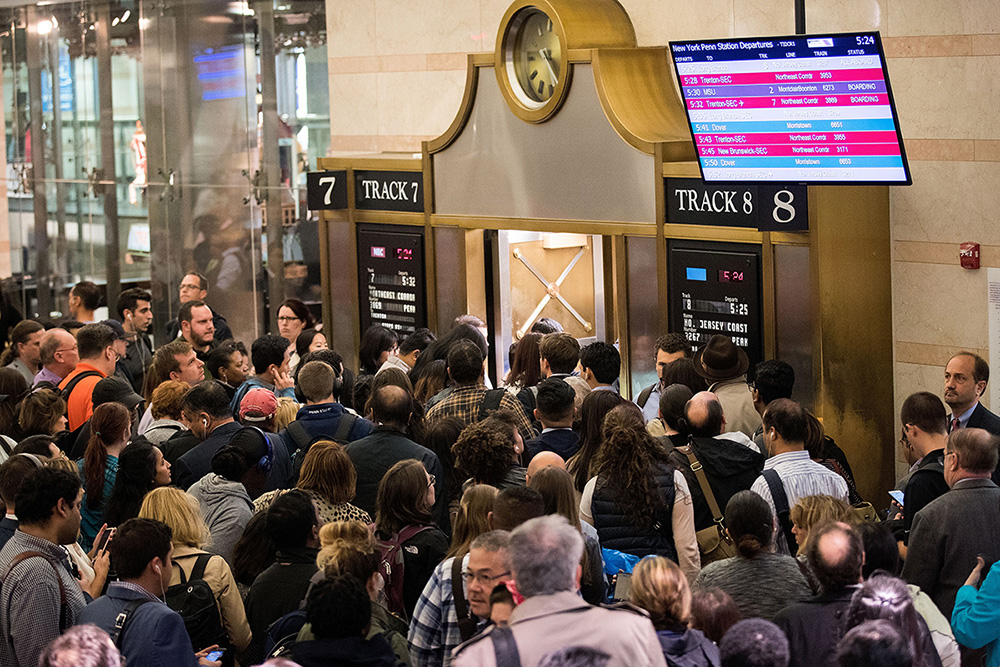Govs. Cuomo and Chris Christie have a challenge: how to help commuters this summer as Penn Station shuts tracks. Instead of calmly and competently tackling this task, however, the governors prefer to team up as bullies — attacking Amtrak, the federal railroad, to cover their own mistakes.
Amtrak, which owns Penn Station, shares blame. Poorly maintained tracks have caused two derailments at Penn this spring. Problems with signals and electrical wires have fouled commutes for NJ Transit and Long Island Rail Road riders for months.
Amtrak didn’t help when it admitted it knew of deteriorated tracks but couldn’t get to fixing them in time to prevent chaos.
But better late than never; Amtrak’s now doing something it should have done sooner: take parts of Penn out of service to do large-scale repair and replacement work. For two periods (July 7-25 and Aug. 4-28), Amtrak will reduce service through Penn by about 25 percent. It’ll do the same thing sometime next year.
This won’t be pleasant, but it is necessary. And commuters generally do well during well-planned disruptions.
People predicted chaos during the during the 2012 London Olympics. But London commuters adjusted their schedules, taking vacation to coincide with the outages and working at home when possible. The same was true during an LA highway renovation.
No, not everyone can go away or work at home. But the people who can, or who can adjust their hours, lessen the burden.
Then what? About 210,000 commuters use Penn Station each day — so a 25 percent decline means having to find service for about 52,000 folk — minus, say, the 8,000 or so who might just skip it altogether.
There are a few options:
Ferries
Cross-river boats could transport about 25,000 people from trains that stop in Hoboken each day with some planning, says Arthur Imperatore, who runs NY Waterway. (New Jersey and New York could commandeer Mayor Bill de Blasio’s new ferryboats.)
During the early April Penn chaos, a temporary ferry served 1,000 people daily, with little notice or preparation.
And “if New York City recognized there was an important need,” he says, a bus-only lane from the ferry dock through Manhattan “would be helpful.”
Buses
Both the LIRR and NJ Transit could supplement train service with extra buses, provided the city gives them a clear path on the streets, just as it did for the MTA after Superstorm Sandy.
Some LIRR riders can take subways, although they, too, are crowded.
PATH trains
Port Authority could up the frequency of its PATH trains from seven minutes to five, making room for another 5,000 people during the morning rush.
No, it’s not great, but it would be endurable.
Longer-term, Amtrak is right when it says that Penn Station cannot handle double its designed capacity forever. So Cuomo and Christie have to figure out — better late than never here, too — how to come up with the billions of dollars to pay for their share of upgrades and expansions.
Yet, instead of getting on with it, they’re creating distractions. Thursday, the two released a slapdash letter blaming Amtrak for Penn’s “intolerable” conditions, and saying that “a professional, qualified, private station operator must be brought in.”
The private sector excels at many things; there’s no evidence — none — that it excels at managing a falling-apart monopoly train station fraught with political and financial woes. Penn Station was private before the government took it over in 1976 . . . because the private railroad that owned it had gone bankrupt.
And train privatization is no sure-fire cure. Britain’s attempts to privatize its rail and subway maintenance ended in two separate disasters that left taxpayers on the hook for billions.
Where would a private-sector operator get the money to make huge capital investments? Christie and Cuomo whine that NJT and the LIRR pay $150 million a year to use Penn each year. But that’s way below market price to maintain and expand the station. Do they want the private operator to have the independence to charge them more?
Finally, unless one of the governors already has someone in mind — they don’t want to approve just any takeover, do they? — it would take years to design and execute a strong management contract for Penn.
Yet riders need repairs now. Without immediate, massive upgrades, they’ll have to suffer through years more of unplanned outages rather than planned ones, and an eventual private buyer might wind up reaping the benefits of these emergency public investments.
Yes, Penn is a mess. But never underestimate our governors’ ability to make it worse — and cost taxpayers more.
This piece originally appeared in the New York Post
______________________
Nicole Gelinas is a senior fellow at the Manhattan Institute and contributing editor at City Journal. Follow her on Twitter here.
This piece originally appeared in New York Post
